2011
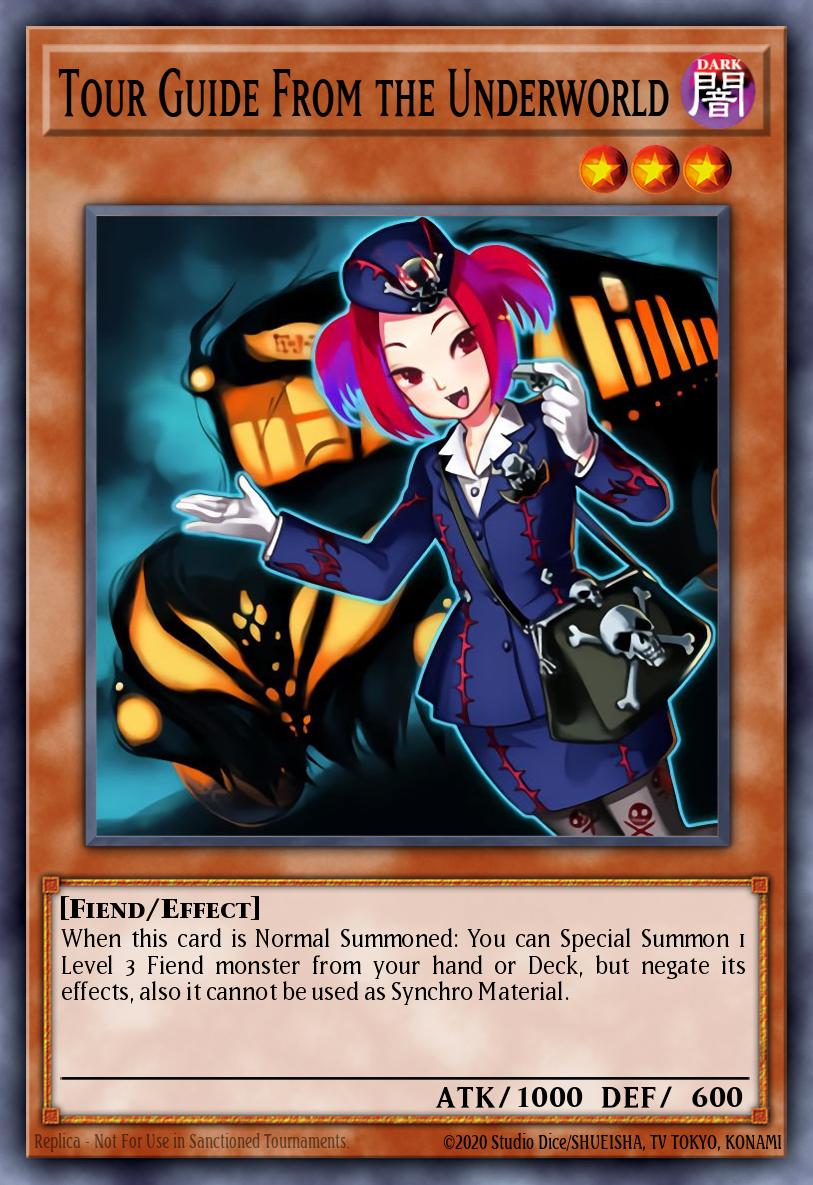 Tour Guide From the Underworld
Tour Guide From the UnderworldXyz Summoning was released in August of 2011 in Generation Force and made relatively little impact on the Synchro Summoning focused meta game of the time. This was largely due to the extremely low power of Xyz monsters that existed at that time in comparison to the power of the Synchro monsters that existed at the same time. This would soon change with the release of Photon Shockwave in November, adding the extremely powerful Rescue Rabbit into the card pool. Rescue Rabbit would catapult Xyz summoning into the spotlight due to the fact that it served as a one-card Xyz for two extremely powerful new Xyz monsters released alongside it: Evolzar Laggia and Evolzar Dolkka. It’s important to note that the deck was able to truly take off as a dominant force in the TCG meta more than it had in the OCG due to Evolzar Dolkka which was a TCG exclusive card. These cards enjoyed their position of power due to their ability to negate almost any card effect. This was particularly powerful because at the time of their release, negation was a mechanic almost exclusively reserved for Trap cards and was very rarely seen as a Monster Effect.
Several other extremely powerful meta-defining cards in this early Xyz period would also be TCG exclusives, allowing the TCG meta to shape itself in a way that the OCG meta never quite was able to. The most significant of these other TCG exclusive cards was Tour Guide From the Underworld, another card that could be a one-card Xyz monster, summoning out any other level 3 Fiend-type monster with which to make a Rank 3 Xyz. The main target for this effect was Sangan, a monster that had served as a staple continuously since its release. Something interesting to note is that early on in the Xyz era, an erroneous ruling was followed that said that Sangan could gain its search effect when detached as an Xyz material, making the Tour Guide and Sangan engine extremely powerful. This ruling was reversed a few months later, but at that point the Tour Guide engine had already found its place in the meta game.
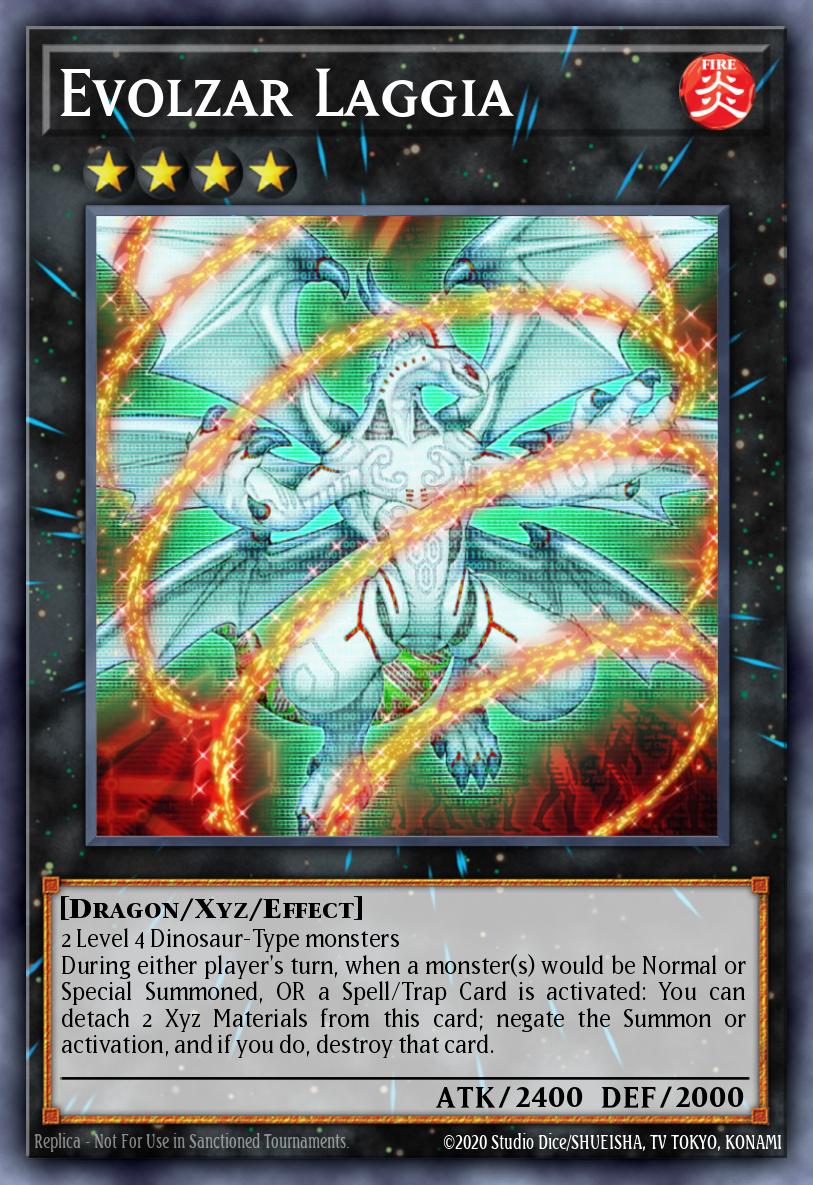 Evolzar Laggia
Evolzar LaggiaThe Dino Rabbit deck, while extremely powerful, definitely did not exist in a vacuum. The previously dominant Plant Synchro deck, despite the hits it had received in the September 2011 Forbidden List, managed to still hold on in the meta and dominated the top spots at the first YCS after Photon Shockwave was released, YCS Kansas City. The continued dominance of the deck at this tournament can be largely attributed to the newness of the Dino Rabbit deck as well as the continued power of cards such as Trishula and the newly legal Black Luster Envoy of the Beginning. Black Luster Soldier had been sitting on the Forbidden List for 6 years when it was finally moved back up to Limited. While the game has definitely sped up since the card’s original Forbidding, it was still extremely powerful in 2011. The impact that this card had on the late 2011 meta can be seen by the winning deck of YCS Kansas City, a dedicated Chaos deck.
The dominance of Plant Synchro would quickly slip away as players became more experienced with Dino Rabbit, causing the results from the next YCS one month later, YCS Brighton, to be far more skewed towards Dino Rabbit. The top cut at this tournament was much more evenly split between Dino Rabbit and Plant Synchro, with Dino Rabbit taking both the top 2 spots this time.
 Grapha, Dragon Lord of Dark World
Grapha, Dragon Lord of Dark WorldWhile the meta was shifting towards Xyz focused decks in the form of Dino Rabbit, another new deck had entered the meta: Dark Worlds. Dark World had seen some minor tournament success during the September 2006 Forbidden List Format, but had quickly slipped away with the Forbidding of Graceful Charity and the shift in the meta away from discard effects. Dark Worlds would be revitalized by the release of a new Structure Deck in October of 2011. This Structure Deck, like many of the recent Structure Decks, gave very powerful support to an older deck and brought it back into the spotlight. The impact that Dark World would have on the meta would, however, be relatively small. The deck managed to get scant few YCS top spots after the release of Photon Shockwave, largely due to the deck’s inability to keep up with the massive advantage generated by Dino Rabbit and Plant Synchro. As a result, Dark Worlds would stay as a rogue deck into the future formats, never really grabbing a significant proportion of tops but frequently appearing in a single spot in various YCS top cuts.
2012
The early 2012 meta was the continued two deck meta of Plant Synchro and Dino Rabbit with occasional showings from Dark Worlds, Six Samurais, Agents, and T.G.. The meta would finally shift away from these older decks with the release of a new booster, Order of Chaos, which came out with new support for two powerful Xyz focused archetypes: Wind-Ups and Inzektors. Wind-Ups had received their initial support in Generation Force and Photon Shockwave, but had been unable to get through the meta of Dino Rabbit and Plant Synchro. Inzektors, on the other hand, were a new archetype released in Order of Chaos.
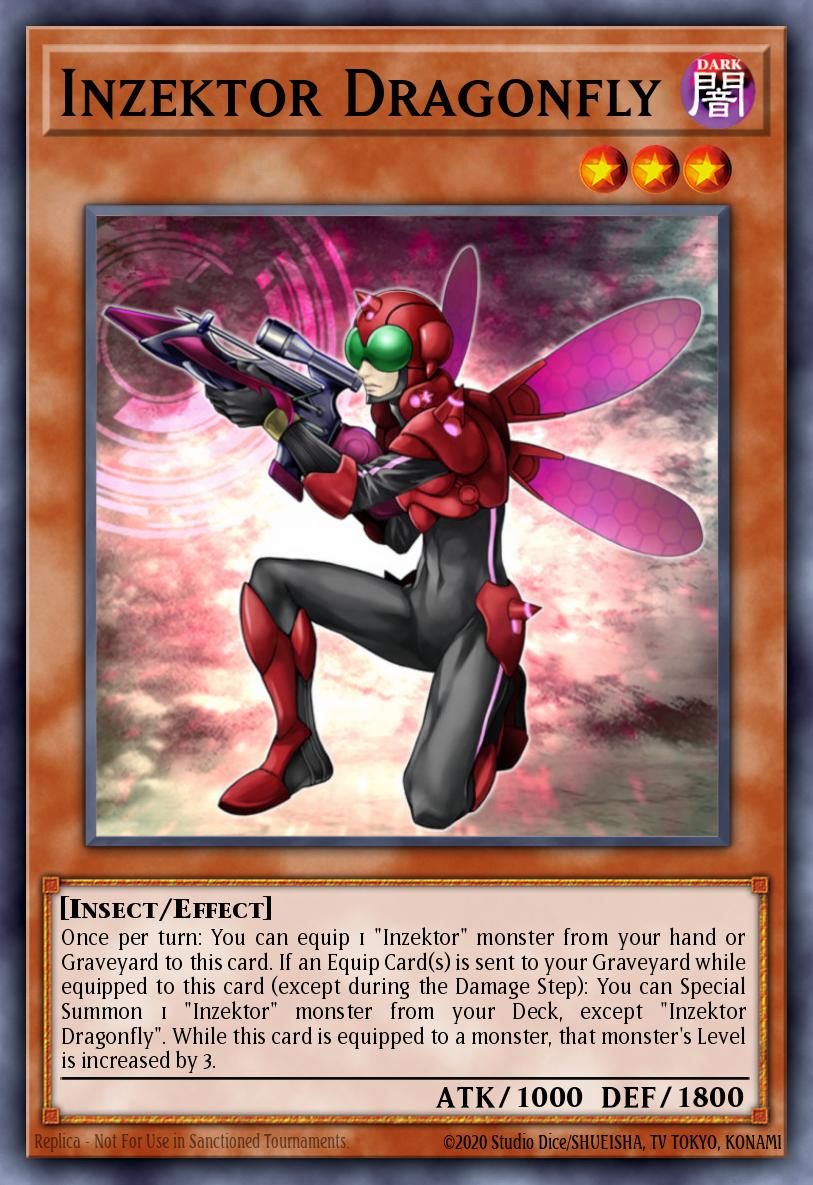 Inzektor Dragonfly
Inzektor DragonflyInzektors were a deck focused around the central combo of using Inzektor Dragonfly’s effect to equip Inzektor Hornet to itself. From there, the Inzektor player could then send Hopper to the Graveyard to destroy any card on the opponent’s field and then Hornet would subsequently Special Summon yet another Inzektor, allowing this move to be performed again. The end result of this combo was 2 of the opponent’s cards being destroyed and two level 3 monsters remaining on the field for a Rank 3 Xyz summon of something like Leviathan Dragon or Wind-up Zenmaines. In the two YCS tournaments that happened in February of 2012, Inzektors and Dino Rabbit would manage to largely push out Plant Synchro from the top cut, with Dino Rabbit finally coming into its own and dominating the majority of the top spots at both YCS tournaments. The meta wasn’t completely dominated by Dino Rabbit, however, as T.G. managed to win at YCS Atlanta in February over Dino Rabbit.
The continued staying power of Synchros in the meta wouldn’t last as the March 2012 Forbidden List made sure to completely annihilate Plant Synchro by Forbidding Glow-Up Bulb, Spore, and Trishula as well as Semi-Limiting Reborn Tengu. Pure T.G. and the T.G. variant of Agents also saw a hit in the form of T.G. Striker being Limited, effectively removing the deck from the meta. The resulting aftermath of this Forbidden List was the meta being shifted away from Synchro decks entirely and towards the new Xyz monsters. The only Synchro deck that was really able to survive this Forbidden List was Six Samurai, largely due to Shien’s Smoke Signal being moved from Limited to Semi-Limited as well as the continued Limited status of Gateway of the Six allowing the deck to still potentially generate huge advantage that was able to match the advantage generated by other decks like Dino Rabbit, Inzektors, and Wind-Ups. The similar levels of many Six Samurai monsters also allowed for the deck to effectively utilize both Synchros and Xyz monsters much more effectively than a deck like Plant Synchro had been able to.
Another significant change also came in April of 2012 with the elimination of Priority. Priority had existed in the TCG since the early days and had been particularly exploited by a variety of popular boss monsters for years, most notably Black Luster Soldier and Dark Armed Dragon. The rule allowed a monster’s Ignition Effects (today referred to as Spell Speed 1) to be activated upon the monster’s summon before that summon could be responded to. However, the rule had been eliminated the previous year in the OCG and by the end of April 2012, the TCG followed suit. While this didn’t fundamentally warp the meta, it did curb the power of various traditional boss monsters while simultaneously encouraging the use of several traps that had previously been much weaker such as Bottomless Trap Hole and Compulsory Evacuation Device. These two cards could now remove a monster from the board before its effect could activate, paving the way for a much more Trap heavy meta.
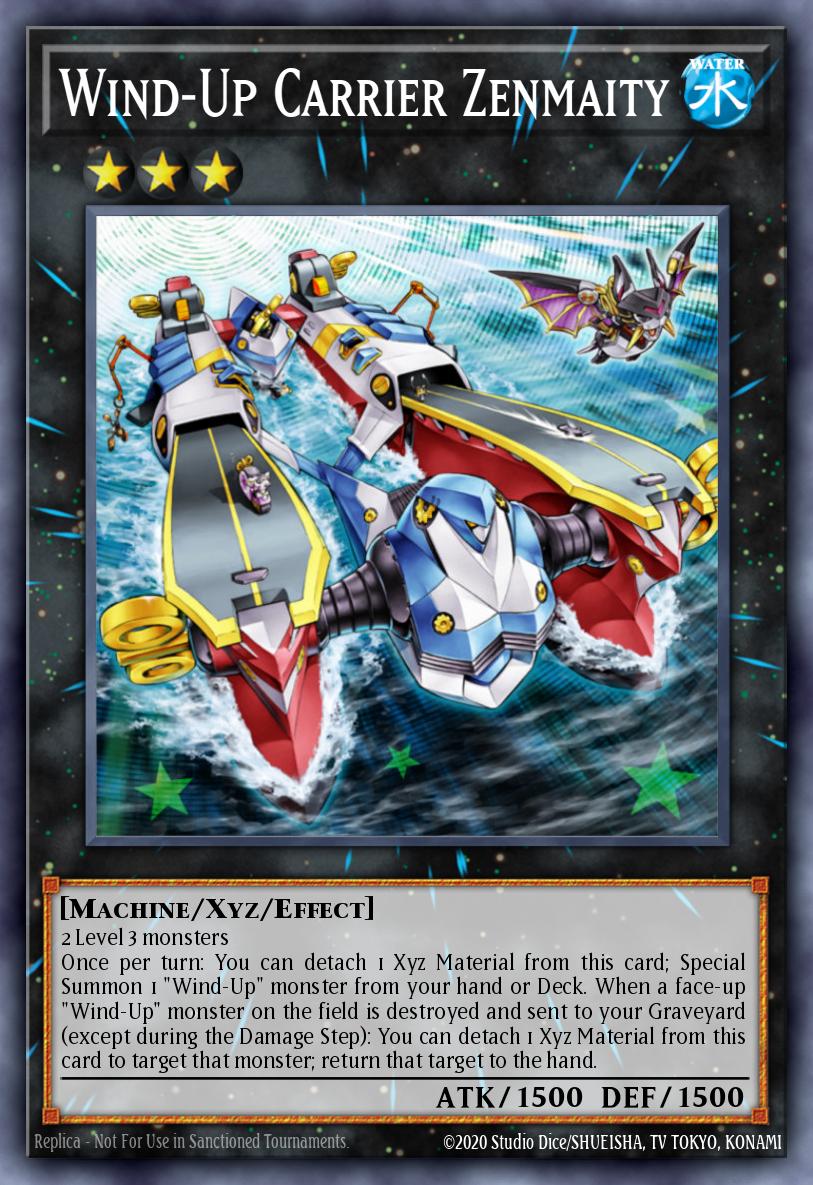 Wind-Up Carrier Zenmaity
Wind-Up Carrier ZenmaityThe meta stabilized around three top decks in the spring of 2012: Dino Rabbit, Wind-Ups, and Inzektors. Wind-Ups were a deck that focused on repeatedly looping a variety of individually weak monsters in order to summon a large number of Xyz monsters to overwhelm opponents. Outside of the general Xyz toolbox capabilities the deck held, what truly made it meta was its ability to perform something known as the Wind-Up Hand Loop. This combo revolved around utilizing Wind-Up Carrier Zenmaity, the new Rank 3 monster the archetype had gained in Order of Chaos, along with Wind-Up Hunter and Wind-Up Rat and could very easily destroy an opponent's entire hand in one turn. Wind-Up Carrier Zenmaity was able to summon out several Wind-Up Hunters which each discarded a card from the opponent’s hand and then Wind-Up Rat could recur any Wind-Up monster from the Graveyard. The standard end result of the Wind-Up Loop was that the opponent would have 4 cards discarded from their hand, meaning they would only start with 2 cards in their hand. The deck also was able to maintain consistency and advantage through the TCG-exclusive Wind-Up monster, Wind-Up Rabbit. When used in tandem with Wind-Up Factory, Wind-Up Rabbit could allow for a search during both a Wind-Up player’s turn and the opponent’s turn while also maintaining a monster on the board that was very difficult to kill, making Xyz summoning easier.
One final deck sprung up during this period as well: Chaos Dragons. Much like Agents the year before, Chaos Dragons received all of their support from a Structure Deck, making them very widely available. The deck followed the footsteps of the Chaos focused Plant Synchro decks that had seen success in late 2011, but with a greater focus on a wider variety of boss monsters. The deck could also abuse Future Fusion for Five-Headed Dragon in order to rapidly fill the grave with various dragon monsters. These Dragon monsters would allow for the easy summoning of the various different Chaos focused boss monsters of the deck. The meta wasn’t just occupied by these four decks, however. A more Xyz focused variant of the 2011 Hero Beat deck also made some significant showings in this format. The main addition to the deck was the rise in the use of Elemental Hero Bubbleman, a card that was previously neglected. However, with the introduction of Xyz monsters, Bubbleman became much more useful due to the ease with which he allowed access to Rank 4 Xyz monsters such as Utopia and Blade Armor Ninja. As this meta was relatively diverse, various rogue decks such as Gadget variants, Gravekeepers, and Lightsworn managed to perform well also. All of these decks received some boon from their ability to utilize the new Xyz monsters due to the relatively generic requirements needed to summon Xyz monsters compared to Synchro Monsters which need Tuners to function.
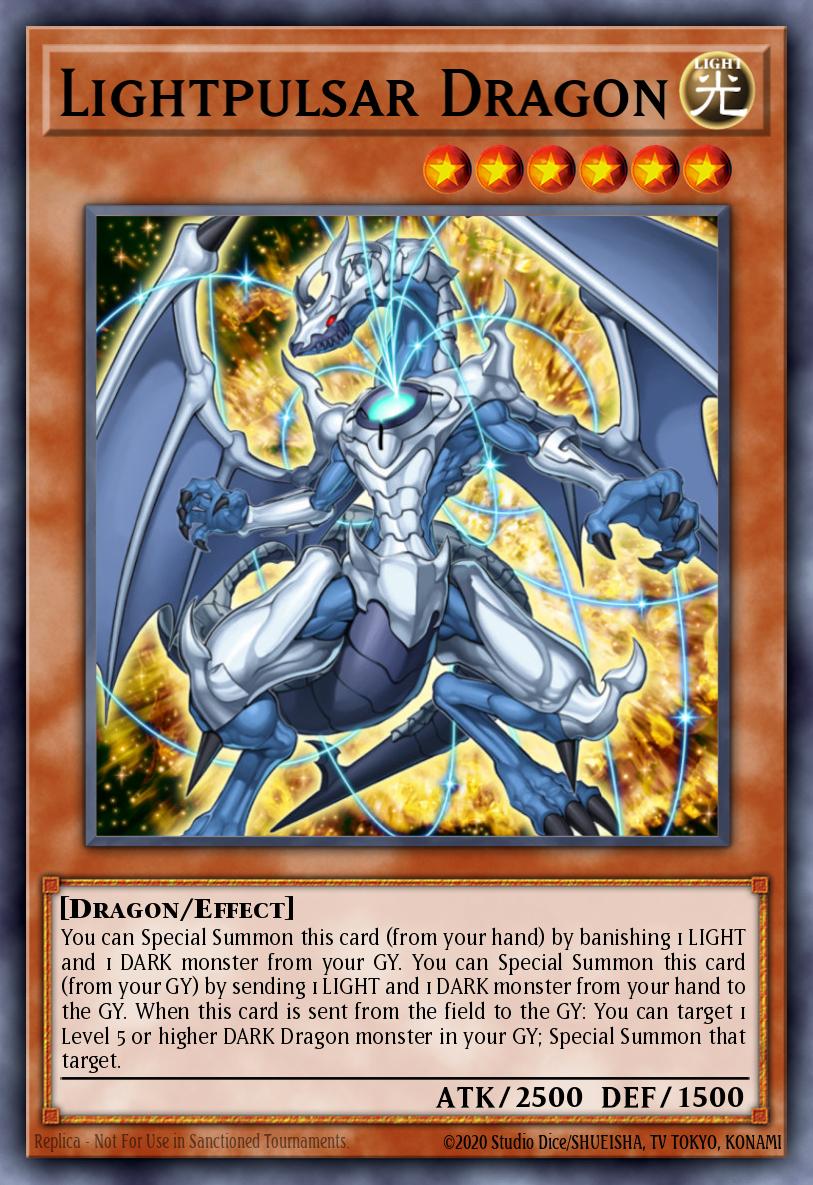 Lightpulsar Dragon
Lightpulsar DragonDuring this period, the frequency of YCS events that were held had increased back to roughly the rate that Upper Deck had held Shonen Jump Championships, meaning the high level meta was able to take much better shape than it had during the Synchro era. Of the 6 YCS events that happened in the March 2012 Forbidden List format, all of them were won by Dino Rabbit or Chaos Dragons except the first of them, YCS Long Beach, which was won by Dark Worlds in their only major event win. The format wasn’t entirely dominated by Dino Rabbit and Chaos Dragons however, as seen when Wind-Ups won both the North American and European World Championship Qualifiers.
All of these top decks would receive some relatively severe hits in the September 2012 Forbidden List with Inzektors and Chaos Dragons taking the brunt of the hits. Both Inzektor Dragonfly and Inzektor Hornet, the two key main deck monsters of the archetype were Limited in this list. As for Chaos Dragons, Future Fusion was Forbidden while Chaos Sorcerer and Red-Eyes Darkness Metal Dragon were both Limited. These hits more or less removed these two decks from being highly competitive in the meta going forward, although Inzektors did still see some success in the months immediately following the implementation of the List. Dino Rabbit also got minor hits in the form of Rescue Rabbit and Tour Guide from the Underworld being Semi-Limited. Although Tour Guide was an essential staple in most decks at this point in the game, Dino Rabbit was particularly reliant on being able to easily summon Leviair using it in order to effectively recycle Rescue Rabbit. Wind-Ups and Heroes also received hits with Wind-Up Carrier Zenmaity being Limited to prevent the Wind-Up Hand Loop and A Hero Lives and E- Emergency Call both being Semi-Limited to reduce the consistency of Hero Beat and also to address the popular OCG Alive Heroes variant that had never caught on in the TCG.
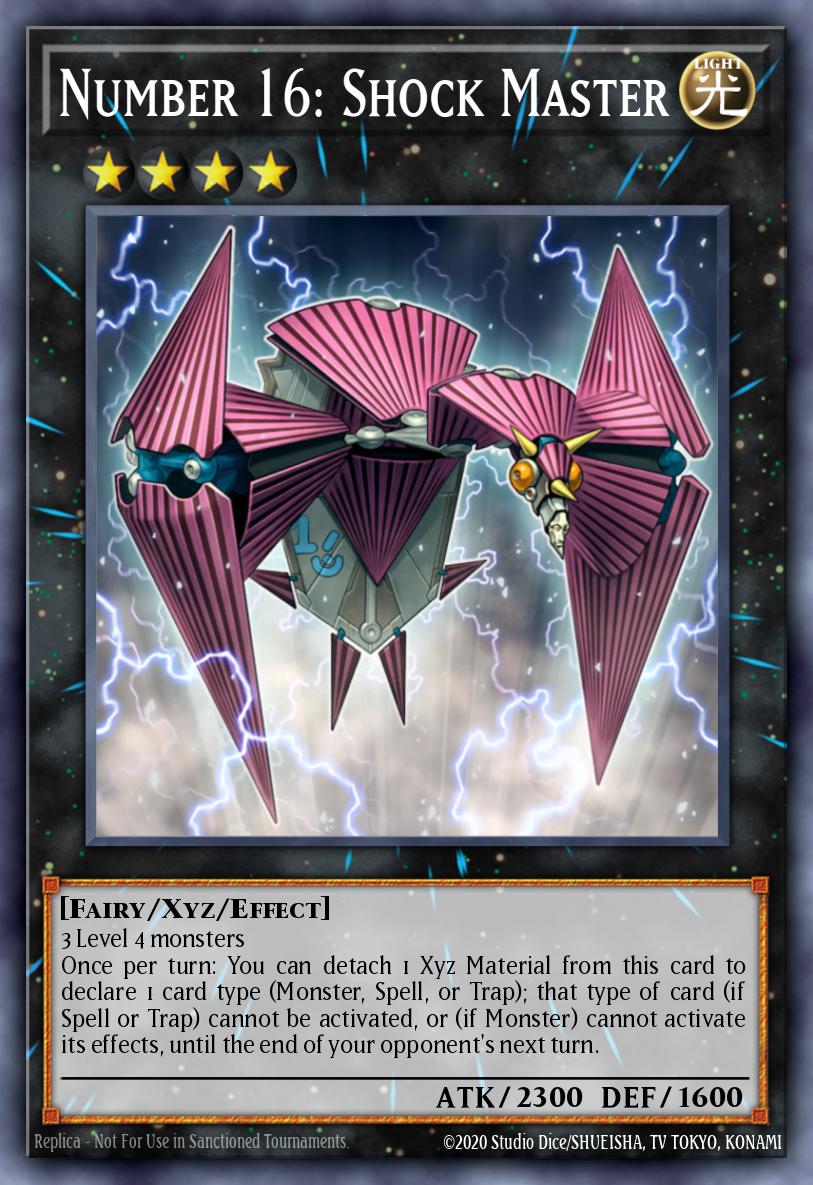 Number 16: Shock Master
Number 16: Shock MasterBecause of the overall evenness of these hits across all of the decks from the previous format, the meta stayed roughly the same, with only Inzektors and Chaos Dragons dropping off. The YCS events that took place in September and October would see very good showings for Wind-Ups, as they ended up controlling the top cuts. Although the Wind-Up Hand Loop had been effectively curbed with the Limiting of Wind-Up Carrier Zenmaity, the deck had successfully shifted gears into more of a rank 3 and 4 Xyz toolbox deck. This new variant was most notable for being able to relatively easily get out Number 16: Shockmaster. Shockmaster was able to completely shut down an entire mechanic for a turn, giving it the ability to both stop an opponent from making plays or make it so that Shockmaster’s controller could OTK an opponent without having to worry about Traps. In addition to Wind-Ups, various different decks that had previously been considered “rogue” or less competitive also managed to find their way higher up into the meta, such as Six Samurai, Machina Gadgets, and Heroes.
A new deck also managed to make its way into the post-September Forbidden List meta: Geargia. This new archetype was released in the August booster set Return of the Duelist and became more meta-relevant after Chaos Dragons and Inzektors dropped off. The deck focused on swarming the field with Xyz monsters and was commonly, especially at this time, used together with the Karakuri monsters that had been released during the Synchro era to allow for high level Synchro plays. While the deck would not become a crushing meta force, the Karakuri variant would manage to win a YCS in October of 2012.
The meta would shift away from the slower pace it had been since the September Forbidden List with the release of a new booster set in November: Abyss Rising. This was a Water attribute themed booster set that was released very close together with a Water themed Structure deck. Together these two releases gave great power to the new dominating meta deck: Mermails. Mermails were much faster and stronger than the meta decks that had preceded them. They were able to very easily OTK opponents off of only 2 or 3 cards due to the sheer power of Mermail Abyssmegalo and the potent board clearing power of Atlantean Marksman and Atlantean Heavy Infantry. The deck was also able to utilize Moulinglacia the Elemental Lord to destroy an opponent’s hand and topped it all off by being able to easily search all of these key combo pieces with 3 copies of Atlantean Dragoons. After being released, while very powerful, Mermails failed to completely push out the old meta as there were enough counters to the main Mermail strategies. In spite of this, Mermails still managed to get a significant number of tops at the last 2 YCS events of 2012. The main decks that prevented Mermail’s total domination were a new variant of Dino Rabbit and the Xyz toolbox Wind-Ups deck, although there were some Agent, Inzektor, and Dark World tops scattered throughout the format. The new variant of Dino-Rabbit that started to rise in popularity was referred to as Macro Rabbit due to its reliance on running 3 copies of Macro Cosmos to shut down Graveyard reliant decks. This was particularly relevant as Mermails were extremely reliant on their monsters being sent to the Graveyard in order to trigger their effects. Because of this, Dino Rabbits were able to often successfully play out a slower control-based game against Mermails and stop themselves from getting quickly OTK’d.
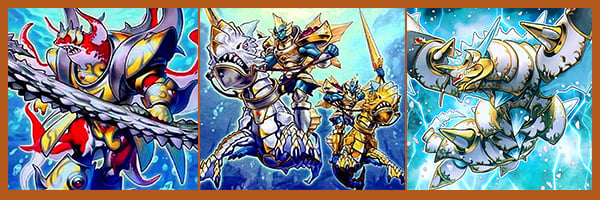 Abyssmegalo, Atlantean Dragoons and Moulinglacia
Abyssmegalo, Atlantean Dragoons and Moulinglacia2013
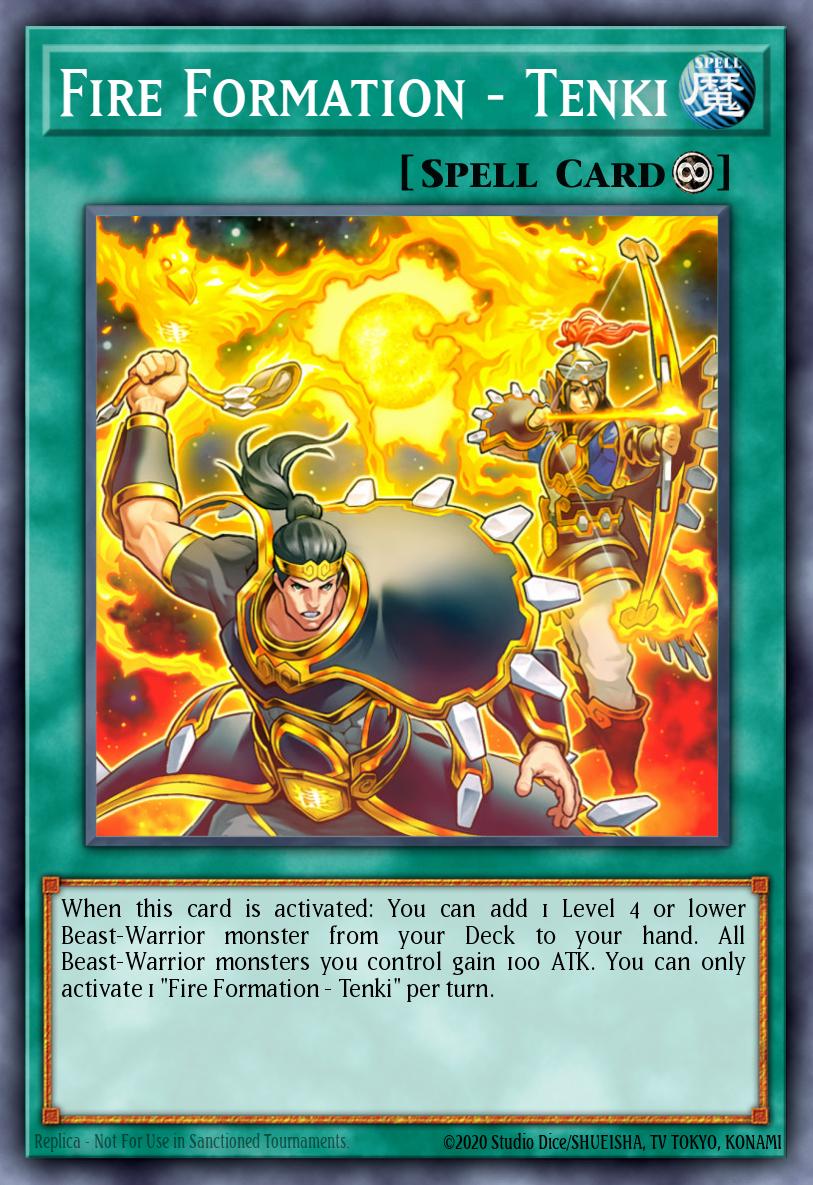 Fire Formation - Tenki
Fire Formation - TenkiEarly 2013 brought about yet another new booster set with a meta threat in it, this time in the form of Fire Fists. Fire Fists, while not as powerful as Mermails, had very high consistency and were able to use their Extra Deck monsters such as Brotherhood of the Fire Fist Tiger King to get through tough boards. The early iterations of the deck made use of the two legal copies of Rescue Rabbit in tandem with Gene-Warped Warwolf to more easily get out the deck’s various Beast-Warrior reliant Xyz monsters. The usage of Rescue Rabbit was then combined with the deck’s high consistency through the use of Fire Formation - Tenki and the ability of Brotherhood of the Fire Fist - Bear to both clear boards and also search the deck for Fire Formation cards.
The March 2013 Forbidden List would bring a significant change to the format by eliminating Wind-Ups. The deck lost its last copy of Wind-Up Carrier Zenmaity and got Wind-Up Magician, one of its key playmakers, Limited. This was primarily done because the September 2013 Forbidden List format had seen constant tops by Wind-Ups in spite of the Limiting of Wind-Up Carrier Zenmaity. The list also notably saw Sangan moved to Forbidden, killing what had been the primary target for Tour Guide.
The resulting format was mostly between Mermails and Fire Fists with Mermails having a clear advantage. As Mermails continued their dominance of the meta, two distinct variations of the deck started to emerge: Genex Mermails and Mono Mermail. Genex Mermail utilized 3 copies of Genex Undine and a single copy of Genex Controller. Genex Undine allowed for the various different Mermail and Atlantean effects to be more easily triggered directly from the deck. This variant of the deck definitely focused more on triggering the effects of the Atlantean monsters over spamming the board with the more powerful high level Mermails. Mono Mermails, on the other hand, played a much fuller Mermail monster lineup. The result of this was much easier swarming capabilities and by extension much easier access to the powerful and emerging rank 7 Xyz pool, which at this point mainly included Mermail Abyssgaios and Number 11: Big Eye.
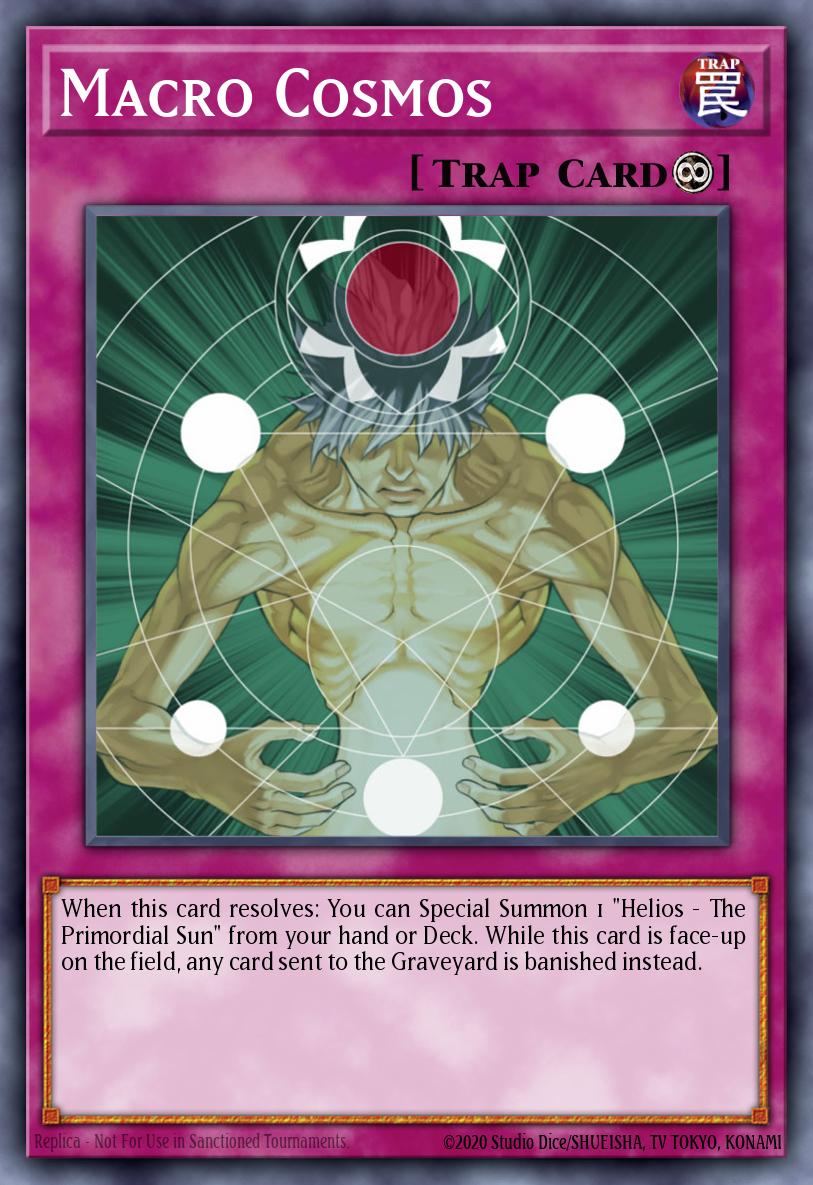 Macro Cosmos
Macro CosmosOther decks from the previous year's format, such as Dino Rabbit and Heroes, also managed to steal some tops despite the format shift. The Macro Rabbit variant that had rose to prominence saw continual event tops throughout the format due to Macro Cosmos’ effectiveness against Mermails, making the deck something of an anti-meta force. Heroes also saw more play in this format under a new variant called Bubble Beat. This version of the deck had dropped the Gemini monsters in favor of a focus on Bubbleman and making rank 4 Xyz monsters. Bubble Beat managed to win one YCS during the March 2013 format and get a few scattered tops at regionals throughout the format. The last major deck of the format was a resurgent Gadget deck. Machina Gadgets had been stealing occasional tops at various events since the first came onto the scene years earlier, but had fallen somewhat out of favor after Xyz took over the meta. The deck would soon come to take full advantage of Xyz monsters, however, easily being able to flood the board with rank 4 Xyz monsters thanks to the potency of Ultimate Offering with the deck. Both the older Machina variant and the somewhat more recent Synchro-focused Karakuri variant of Gadgets both saw substantial success at various regionals throughout the format as well as some minor success at the YCS events of the format.
The playing field of the March 2013 Forbidden List meta would prove to be short lived as the release of the booster set Lord of the Tachyon Galaxy in May would blow all older decks out of the water. Lord of the Tachyon Galaxy began a new era of the game and also started the most infamous format in all of Yu-Gi-Oh!'s history: Dragon Ruler format. The Dragon Rulers were a set of 4 monsters, all of which were level 7 Dragons that could summon themselves from hand or Graveyard by banishing two other Dragons or monsters of the same attribute as the Dragon Ruler. They all also had an ability they could trigger by discarding themselves and another monster of the same attribute from hand. Finally, they all allowed another Dragon of their same attribute to be searched when they got banished, including another copy of that same Dragon Ruler. These factors combined together to make a deck that was faster, more powerful, and more consistent than anything that had ever come before it. Dragon Rulers were able to banish other Dragon Rulers to summon themselves, then causing those banished Dragon Rulers to search out additional copies of themselves, maintaining complete card advantage. To top it all off, there were lower level equivalents to all of the Dragon Rulers as well that made summoning them from the deck even easier.
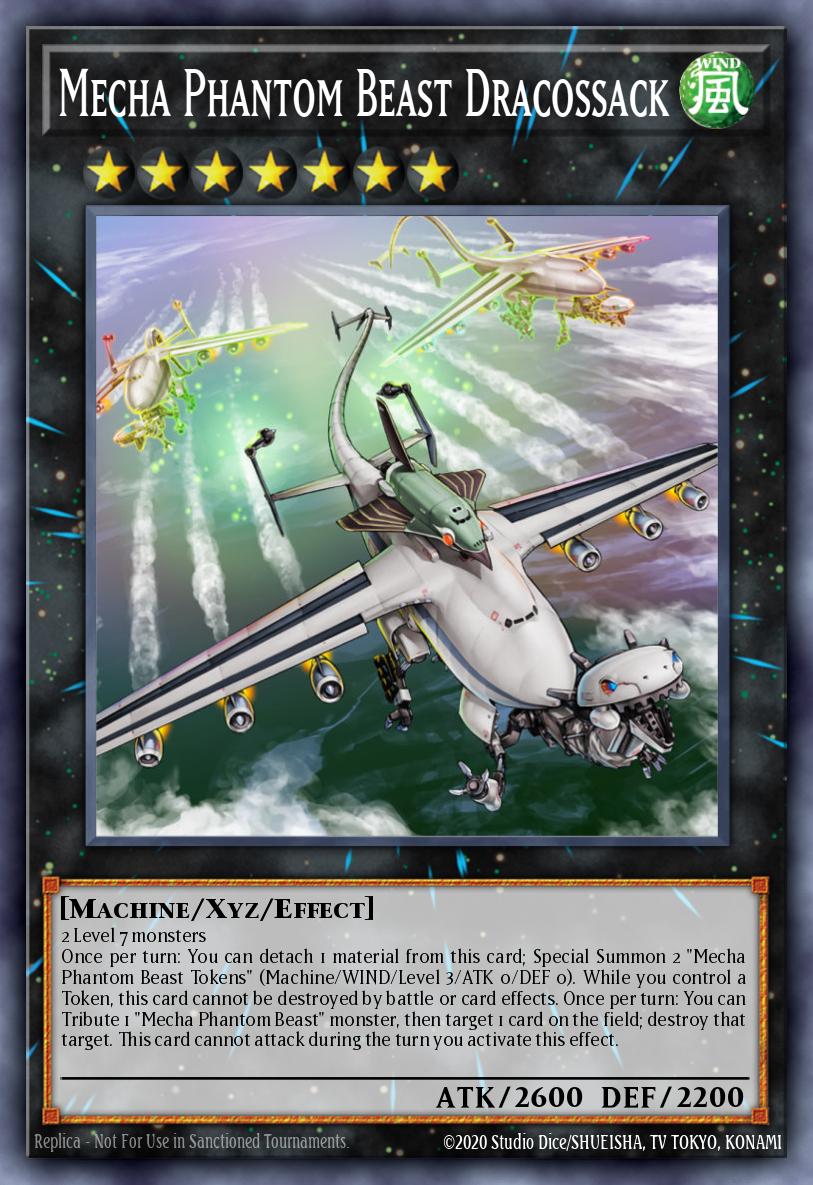 Mecha Phantom Beast Dracossack
Mecha Phantom Beast DracossackThe true power of the Dragon Ruler deck didn’t rely on the monsters themselves, but instead on the Extra Deck monsters that they facilitated summoning. This primarily included rank 7 Xyz monsters and some level 8 Synchro monsters. The two rank 7 Xyz monsters that were most prominently associated with the deck were Mecha Phantom Beast Dracossack and Number 11: Big Eye. Dracossack was notable for having a combination of high attack, the ability to establish board presence, a destruction effect, and protection from destruction to top it all off. Big Eye, on the other hand, gave the deck utility by stealing a opponent’s monsters, simultaneously dismantling an opponent’s board while also getting the opponent’s powerful monster effects. The level 8 Synchro monsters that the deck often had access to through the use of Flamvell Guard or Dragunity Corsesca included many of the most powerful level 8 Synchro monsters from the 5D’s era including Stardust Dragon, Scrap Dragon, and the newer Crimson Blader. This wide variety of extremely powerful boss monsters helped make the deck a very formidable force.
The deck also had incredible draw power in the form of three cards: Sacred Sword of Seven Stars, Super Rejuvenation, and Gold Sarcophagus. Both Gold Sarcophagus and Sacred Sword thinned the deck and banished Dragon Rulers to get their searches while Super Rejuvenation allowed a Dragon Ruler player to draw through their deck and replenish their hand at the end of the turn. While Sacred Sword was used throughout the format, early on it didn’t see universal play and when it was played, it was often only run at 1 or 2 copies. The other main tech for Dragon Rulers was Light and Darkness Dragon. This card saw a resurgence in play due to the ability for it to be searched from the deck by banishing Eclipse Wyvern as well as the ease with which Dragon Rulers could use themselves and Dracossack tokens to generate tribute fodder. While Light and Darkness Dragon never quite saw widespread adoption during the format, it did see success with the winning decks at the Oceanic, Polish, and Mexican World Championship Qualifiers.
The final tech of the format came with the adoption of a card previously used primarily in side decks as a main deck choice: Vanity’s Emptiness. This card, which had been seen as largely useless prior to the Dragon Ruler format, rose to prominence due to its potency to shut an opponent out of playing in the Dragon Ruler mirror match. The factor that gave the card this was primarily that Dragon Rulers all summoned themselves by card effect meaning that Vanity’s Emptiness could be chained to the Dragon Ruler’s attempted summon and then stop that summon, subsequently wasting the resources used for the aborted summon and locking the opponent out of establishing board presence. Furthermore, the condition for Vanity’s Emptiness’s destruction made it relatively easy for Dragon Rulers to remove it from their own field on their turn, allowing them to then continue Special Summoning. While Vanity’s Emptiness would clearly show itself as an extremely powerful choice for Dragon Rulers, the card wouldn’t see mainstream adoption until near the end of the format.
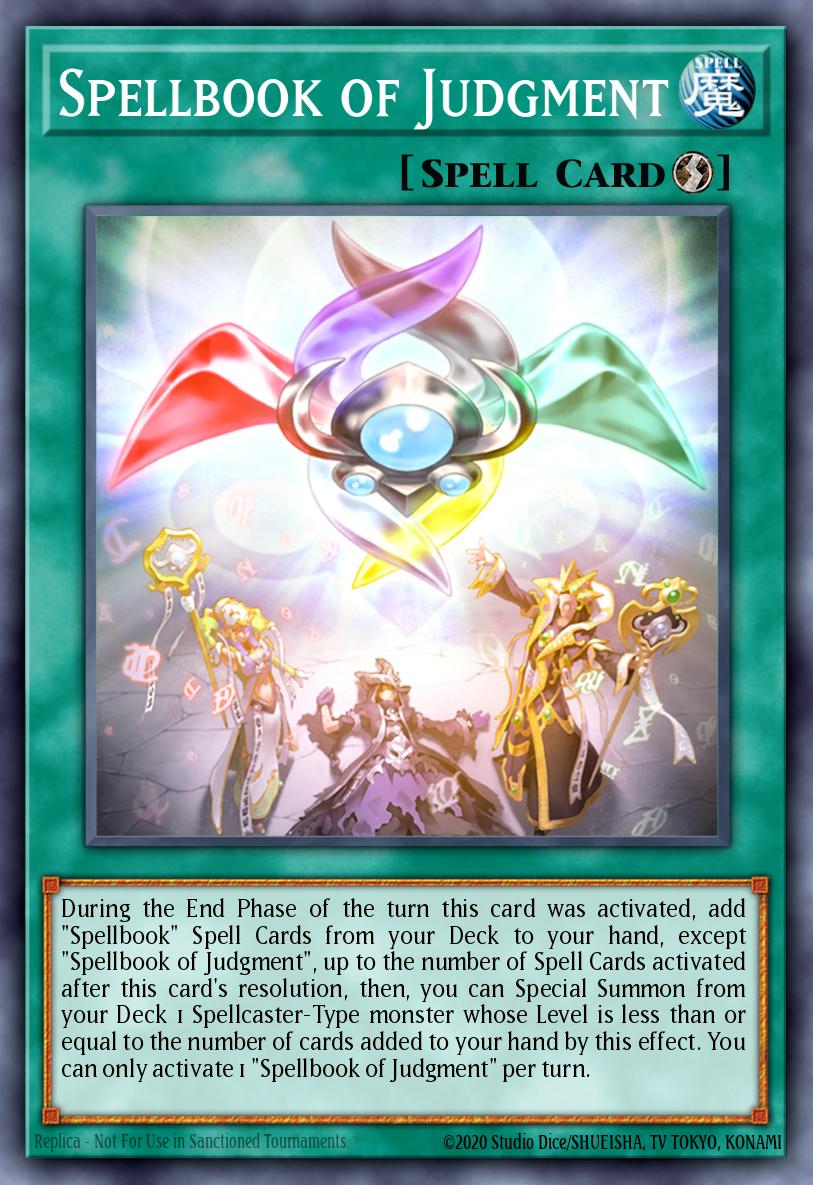 Spellbook of Judgment
Spellbook of JudgmentDragon Rulers made short work of the meta, almost entirely pushing out all other decks within the span of a few weeks. Soon enough, the only decks that could compete were either Dragon Rulers or decks specifically designed to counter Dragon Rulers. There were two major decks that fell into this latter category: Spellbooks and Evilswarm. Spellbooks were a primarily Spell based deck that relied on extremely high consistency for getting to their power card, Spellbook of Judgment. This card allowed a Spellbook player to end their turn by replenishing their hand to full size with new Spellbook spells as well as Special Summon a Spellcaster from the deck. The one that was most often chosen was Jowgen the Spiritualist as he was able to shut off Special Summoning, something which Dragon Rulers relied heavily on. Furthermore, Spellbooks had access to Spellbook of Fate which could banish an opponent’s monsters, making it difficult to get rid of Jowgen.
The other prominent anti-Dragon Rulers deck at the time was Evilswarm. The point of Evilswarm was similar to Spellbooks in that it focused on getting out their Xyz monster, Evilswarm Ophion, as fast as possible. Ophion stopped the summoning of level 5 or higher monsters which shut off Dragon Rulers. Evilswarm also had an easy way to protect its boss monster with Infestation Pandemic that Ophion could search with his own effect. This gave Ophion protection from being removed from the board by cards such as Dark Hole and Spellbook of Fate or from being flipped face down by Book of Moon.
Something interesting to note about this format was the lack of YCS events. The last YCS event in the TCG held before the various World Championship Qualifiers for the year occurred the weekend before the release of Lord of the Tachyon Galaxy, meaning that Dragon Rulers were not yet legal for play at the event. As such, the main tournaments where Dragon Rulers shone were the various different World Championship Qualifiers that occurred. While Dragon Rulers definitely dominated the majority of top spots and wins, Evilswarms and Spellbooks did manage to seize a significant number of tops and wins at these events with Spellbooks even taking first place over Dragon Rulers at the European World Championship Qualifier.
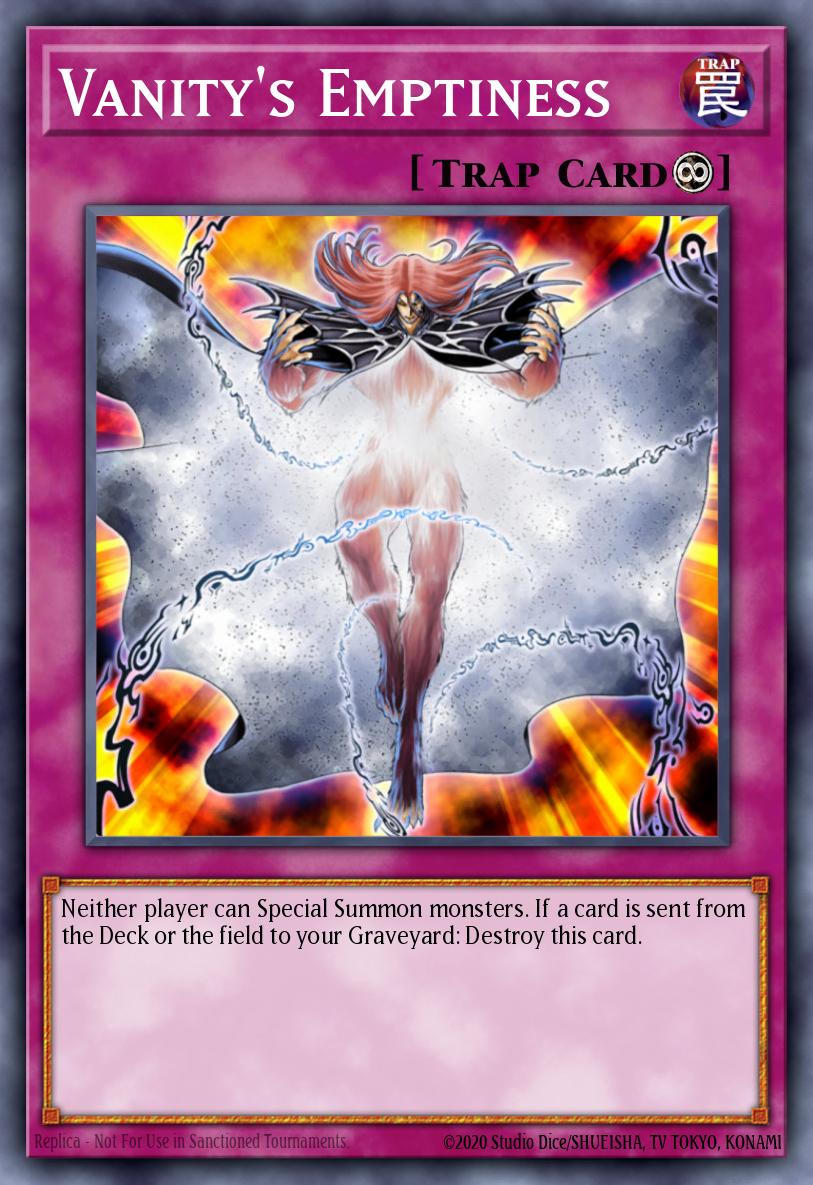 Vanity's Emptiness
Vanity's EmptinessThe format finally ended with the release of the September 2013 Forbidden List which was one of the largest Forbidden Lists released so far, especially in terms of number of decks that received hits. It is also important to note that this Forbidden List was the first to officially diverge from the OCG. Previously, all Forbidden and Limited Lists had been released for both regions, but the September 2013 List denoted an official divergence between the two meta games. To address Dragon Rulers, all of the baby Dragon Rulers, Super Rejuvenation, and Card Destruction (another consistency card for the deck) were Forbidden and Gold Sarcophagus was Limited. Dragon Rulers weren't the only deck hit on this list however. Spellbooks lost Spellbook of Judgment, Mermails got Atlantean Dragoons and Deep Sea Diva limited, Fire Fists got Brotherhood of the Fire Fist Spirit Limited and Fire Formation Tenki Semi-Limited, and Gadgets got both Shock Master and Ultimate Offering Forbidden. Two older decks, Six Samurai and Bubble Beat, also got key consistency cards hit to prevent them from truly making a comeback. Six Samurai saw Gateway of the Six Forbidden while Bubble Beat saw Elemental Hero Stratos Forbidden.
The result of this list was Spellbooks falling from the top tier of the meta and Dragon Rulers seemingly becoming beatable. However, Dragon Rulers would adapt and maintain their spot as the best deck. This was largely due to the continued power of the core Dragon Ruler cards in addition to the simultaneous weakening of any of the possible competitor decks that could have pushed Dragon rulers out of their top spot. The main hybrid of Dragon Rulers that appeared after the September List was referred to as Ravine Rulers. This variant relied on using the field spell Dragon Ravine to very quickly fill the Graveyard with Dragon Ruler monsters while also being able to search out the various Dragunity tuner monsters to make easy Synchro plays. This variant of the deck was further enhanced by a newly released trap card, Sixth Sense. Sixth Sense had been released many years earlier in the OCG and had been on the Forbidden section of the Forbidden and Limited List for as long as there had been one, but it was new to the TCG in fall of 2013. The card allowed for huge amounts of advantage to easily be accumulated by letting a player either draw a large number of cards or mill a large number of cards, both results being optimal for Dragon Rulers. It was immediately Limited, but this was not enough to prevent it from being used in every Dragon Ruler deck. Ravine Rulers also began to exploit Return from the Different Dimension, a card that hadn't seen widespread play since the end of the Dark Armed Dragon formats 5 years earlier.
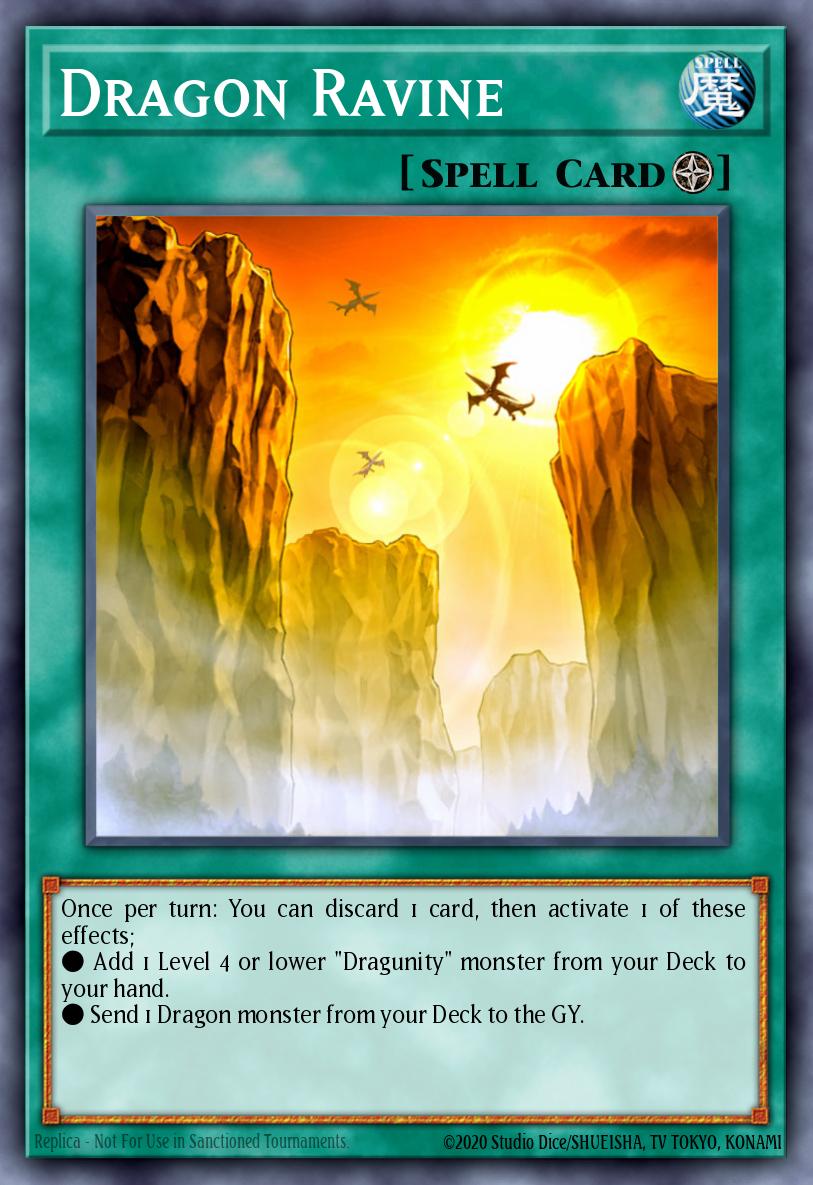 Dragon Ravine
Dragon RavineBecause of these new power cards and Spellbook’s inability to now keep up with Dragon Rulers due to the loss of Spellbook of Judgment, Ravine Rulers ended up having an even greater portion of event tops than the full power version of the deck had, with their only serious competition remaining being Evilswarms. While the first YCS of the format, YCS Toronto, saw Mermails and a variety of other previously rogue decks take a significant portion of the top spots, this can largely be attributed to the format still being young enough that Ravine Rulers hadn’t fully solidified in the meta. Once the format coalesced around Ravine Rulers, they saw complete and utter dominance of the remaining high level events of the year, winning almost all of the top spots.
There were, however, some rogue decks that managed to survive in this format at the regionals level. These included Constellars, Madolche, Mermails, and Fire Fists. Constellars and Madolche were both decks that had come out around the time that Dragon Rulers first entered the meta so they had no time to shine. They became more relevant at this point because both decks had very easy access to Xyz monsters that could remove an opponent's monsters without banishing or destroying them, something that was particularly relevant with Dragon Ruler's easy access to Dracossack and Stardust Dragon in addition to the fact that Dragon Rulers could be summoned just as easily from the Graveyard as they could from the hand.
Dragon Rulers would not continue their reign for long, however, as Konami changed their schedule to have 4 new Forbidden and Limited Lists per year instead of 2 like there had been since 2005. As part of this change, it was announced a new Forbidden and Limited List would take effect on January 1st of 2014. This new Forbidden and Limited List killed the remaining power of Ravine Rulers, specifically targeting all of the deck's power cards. First of all Sixth Sense, Return from the Different Dimension, and Dragon Ravine were all Forbidden and Sacred Sword of Seven Stars and all 4 Dragon Rulers were Limited. Further hits on this list included limiting Spellbook of Fate to make sure Spellbooks would not be able to dominate the power vacuum left by Dragon Rulers. The end of the Dragon Ruler formats would spell another major swing in the overall meta of the Yu-Gi-Oh! TCG not unlike that seen at the end of the Dark Armed Dragon era. While the game up to this point had seen many diverse and open metas, the playing field of competitive decks changed relatively slowly, with a new competitive deck usually cropping up only every 2 or 3 months. These decks were also low enough in power that many older decks, such as Six Samurai, Gravekeepers, and Dark Worlds, were able to remain competitive throughout the years. The era that the game was about to shift to would be defined not by singular dominant decks, but instead by a long string of wildly swinging meta games, with whole sets of new decks popping into the competitive scene and disappearing from it just as fast. It’s in this era that the modern game of Yu-Gi-Oh! would appear.
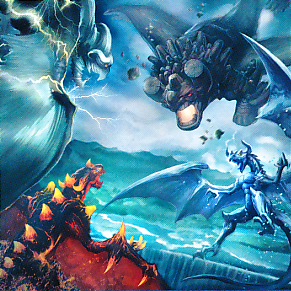 All 4 Dragon Rulers, as depicted in the art for Dragoroar
All 4 Dragon Rulers, as depicted in the art for Dragoroar2014
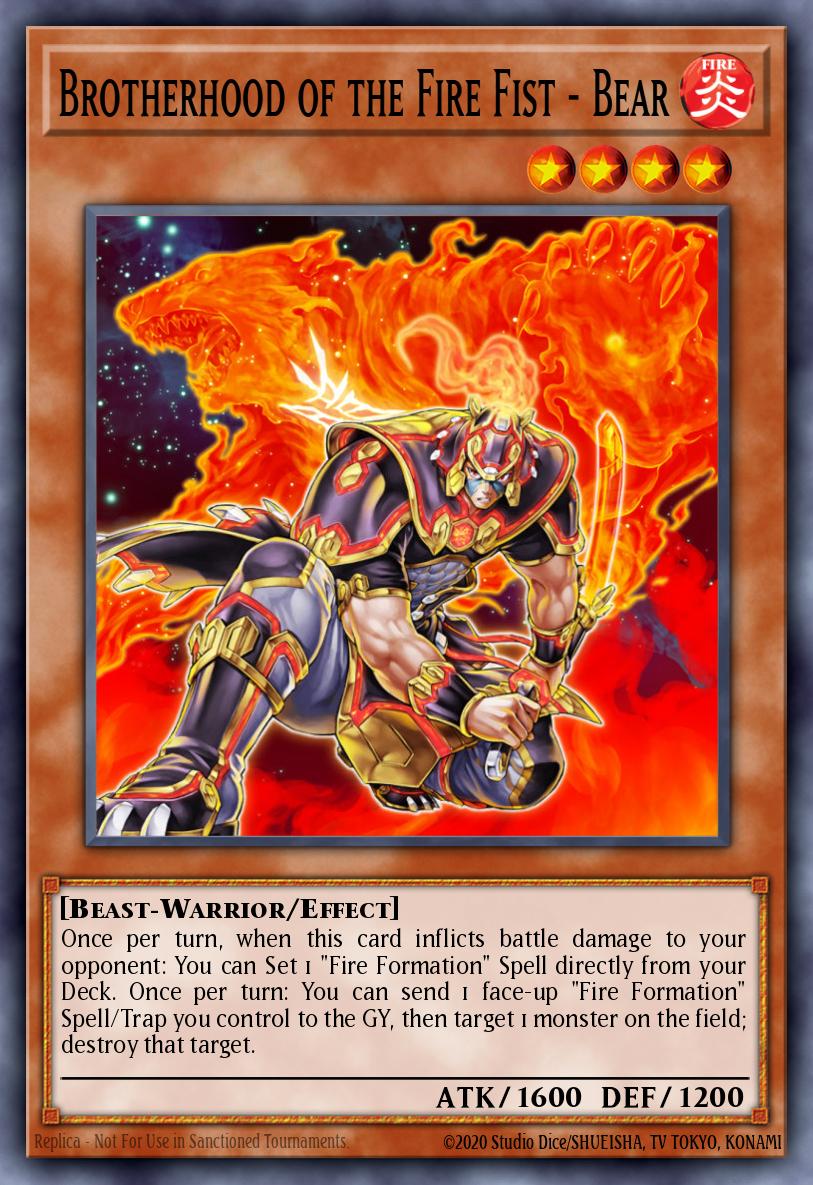 Brotherhood of the Fire Fist - Bear
Brotherhood of the Fire Fist - BearThe year opened with the enforcement of the new January Forbidden and Limited List, which destroyed Dragon Rulers as a dedicated deck and hindered Spellbooks severely. With Dragon Rulers and Spellbooks severely weakened and Tenki being put back at 3 copies, Fire Fists would proceed to dominate the upcoming format. This new era of Fire Fists was referred to as +1 Fire Fists due to the easy card advantage that the deck was able to generate. They also took advantage of an older card that was released during the 5D's era as support for Flamvells: Rekindling. Rekindling allowed for very explosive recovery plays to be done by Fire Fists that they had not been able to perform before. The main cards that could be summoned off of Rekindling were Brotherhood of the Fire Fist Spirit and Brotherhood of the Fire Fist Leopard. This made the card especially useful as Spirit was the deck's Tuner and was Limited at the time, meaning Rekindling was one of the only ways to recur it effectively. Outside of Rekindling, most of what made Fire Fists a powerful contender in the meta was the same reasons the deck had originally risen to prominence: consistency and swarming. The deck was able to easily get a large number of Extra Deck monsters onto the board while also maintaining hand advantage and dismantling an opponent’s board with cards such as Brotherhood of the Fire Fist Bear.
A large variety of other decks also saw widespread play and tops during this period. Some of these decks included Mermails, Geargia, Harpies, Bujins, and a new Xyz focused variant of Infernities. Mermails had managed to hold on in the meta despite Atlantean Dragoons still being Limited due to the overall weakening of the meta. Due to their strong OTK potential, the deck would serve as the main foil to Fire Fists, getting a large number of regional tops while also slowly edging Fire Fist’s dominance of YCS events as the format evolved. The main new addition to the Mermail deck compared to how it had been played before Dragon Ruler format was Tidal, the WATER Dragon Ruler. While this was not a huge change for the deck, it did provide utility and easier rank 7 access.
Before getting into the other new decks that entered the 2014 meta, I want to discuss the rank 4 Xyz pool. Prior to Dragon Rulers, most of the powerful Xyz in the available card pool were restricted to being played only in certain decks, with the most powerful generic Xyz lying in the rank 3 pool with cards such as Wind-Up Zenmaines and Leviair the Sea Dragon. However, during Dragon Ruler format several new and increasingly more powerful generic rank 4 Xyz monsters started to get their release. These include cards such as Lavalval Chain, Number 101: Silent Honor ARK, and Evilswarm Exciton Knight. The release of all of these powerful generic rank 4 monsters made rank 4 Xyz become the standard "best" rank for Xyz summoning. As such, most of the decks that were able to compete in this format had easy access to this generic rank 4 pool.
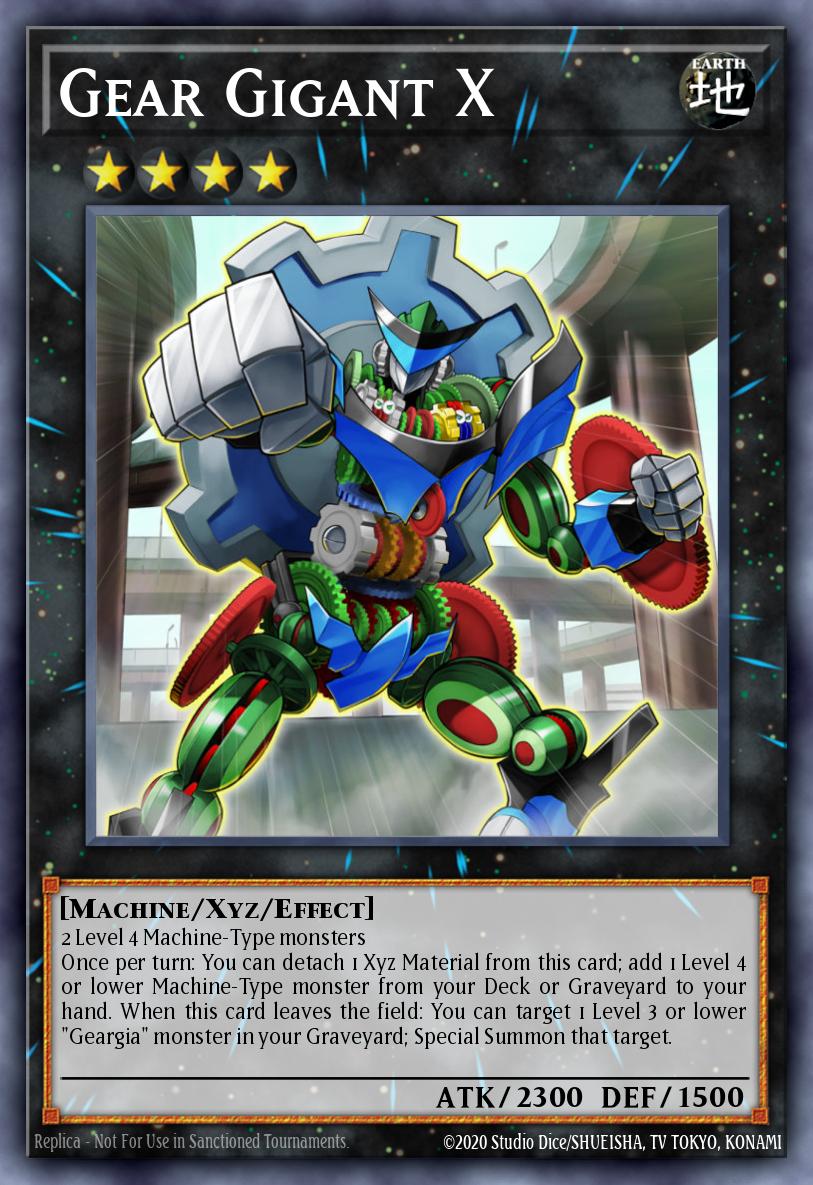 Gear Gigant X
Gear Gigant XThe first of these decks was Geargia. While Geargia had seen some brief success in the short September 2012 meta before the release of Mermails, they had severely dropped off in play since then, only starting to make a comeback at regionals in late 2013. With Dragon Rulers removed from the equation, Geargia was able to shine with their consistent ability to flood the board and make rank 3 and 4 Xyz monsters. Geargia had also received two important pieces of support since Dragon Rulers were released: a structure deck in late 2013 that gave the deck some new support and made it much cheaper and more accessible to all players as well as Geargiagear, a trap card released in Lord of the Tachyon Galaxy. With this new support, Geargia was able to establish itself as one of the most prominent “Xyz spam” decks of the format.
The next deck was Harpies, another deck that had received its powerful new support at the same time that Dragon Rulers were released. Harpies had easy access to the standard rank 4 Xyz pool but they also had several advantages over a standard rank 4 deck. First off, their field spell allowed them to remove Spells and Traps very easily, making them particularly relevant against a lot of the trap heavy decks of the time. Being Wind monsters, Harpies also had access to 2 extremely powerful and unique rank 4 Xyz monsters: Lightning Chidori and Ice Beast Zerofyne. Lightning Chidori allowed for not only non-destruction removal, something that was becoming more relevant, but also helped set an opponent back a turn by making them redraw the same card that was removed. Ice Beast Zerofyne was also extremely powerful as it negated the effects of all face-up monsters, allowing it to deal with a variety of otherwise powerful monsters and face-up Spells and Traps. Altogether, Harpies had access to a very potent card pool which is what allowed them to occupy a relatively large portion of the early 2014 meta.
Yet another new archetype that started to see play in early 2014 was Bujin. While Bujins had the ability to go into rank 4 Xyz monsters, their power was instead centered in their slower and more boss monster oriented playstyle. Bujins relied on a variety of monsters that could be banished from the Graveyard, as well as hand traps that could buff attack including both the in archetype Bujingi Crane and Honest. These monsters were all centered around protecting their main monster, Bujin Yamato. Because of Bujins' slower and more hand trap oriented playstyle, they were able to establish a small foothold in the meta, but were unable to surpass the speed and power that decks like Mermails and Fire Fists could offer.
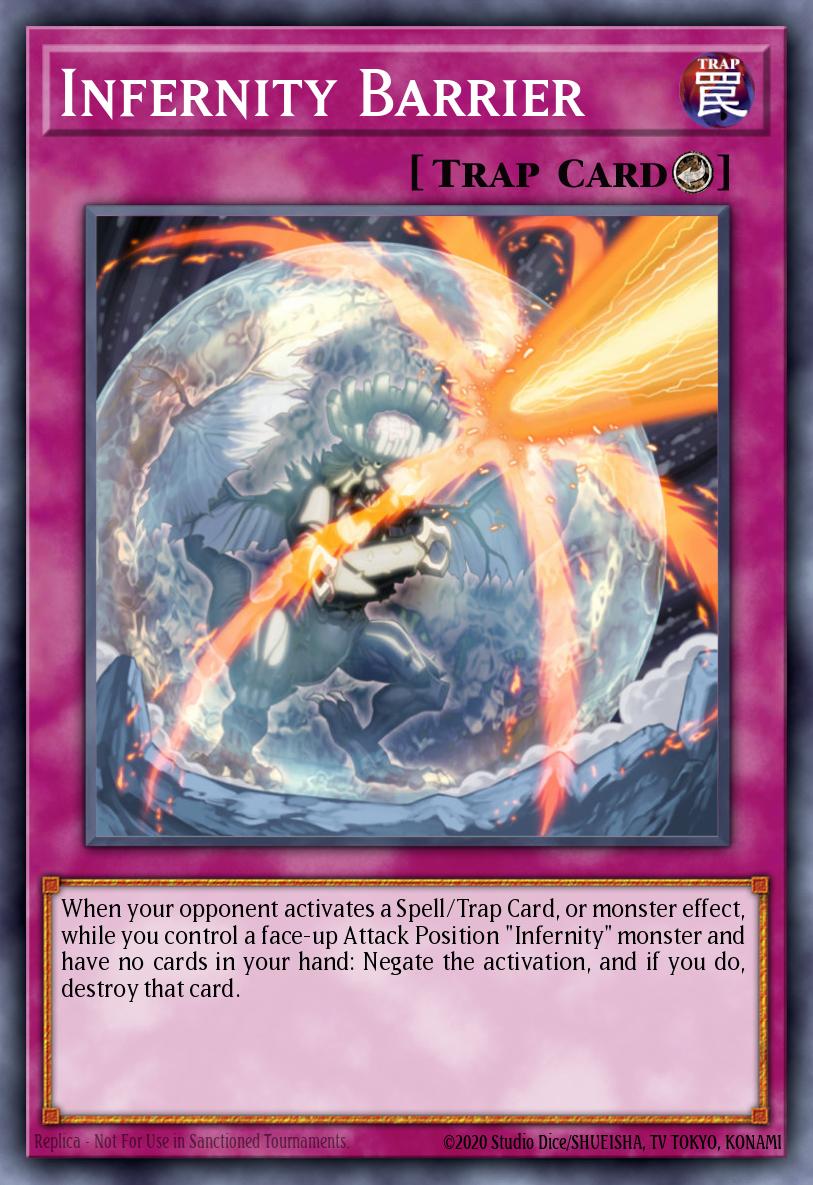 Inernity Barrier
Inernity BarrierThe final deck that started to see play in the early 2014 meta was a resurgent Infernities. While Infernity Launcher had been Limited all the way back in the 5D’s era, Infernities got a new lease on life with the introduction of Xyz. The deck shifted its focus to utilizing a newer rank 4 Xyz called Lavalval Chain. This monster allowed a player to either send a monster from their deck to the Graveyard to place it on top of the deck. This stacking effect synergized extremely well with Infernity’s key card, Infernity Archfiend. When Infernity Archfiend was drawn into an empty hand, it could be Special Summoned and then search any other Infernity card out from the deck, including any of the Infernity Spell or Trap cards. This potent combination allowed Infernities to very easily spam the board with Xyz and Synchro monsters. They were also still further backed up by the powerful Infernity Barrier trap, giving the deck an element of control. While the deck definitely was very powerful, it was not able to fully keep up with Fire Fists and Mermails and only saw a handful of tops during the early 2014 format.
Even though there were a wide variety of different decks that were able to rise into the meta in place of Dragon Rulers, it is also important to note that Dragon Rulers and Spellbooks were by no means out of the meta entirely. The new variant of Dragon Rulers that started to see play in this January 2014 format was Hieratic Dragon Rulers which was able to access Rank 6 Xyz monsters and Synchros with relative ease. It was definitely not as powerful as its previous incarnations, but the deck still managed to gain a decent portion of tops at large events during the period. The focus of the deck was less on the Dragon Rulers as the main strategy and instead used them as more of an engine to complement the other Dragon monsters the deck used. Spellbooks also saw limited success, but with no Spellbook of Judgment and only a single Spellbook of Fate they weren’t able to see widespread success at higher levels of play.
By the end of the January 2014 Forbidden List format, while Fire Fists and Mermails had etched themselves out as the best decks. While they didn’t completely oppress the meta like decks had in previous formats, the April 2014 Forbidden List still focused on addressing them. The list Limited Coach Soldier Wolfbark and Rekindling for Fire Fists and Mermail Abyssgunde for Mermails, all of which were powerful playmakers in their respective decks. Infernities also got checked in the form of an Infernity Barrier Limit. This hit lowered the extremely potent first turn potential that the deck had as Infernity Barrier was an easily searchable negation card. Finally, Hieratic Rulers got a hit in the form of a Semi-Limit to Hieratic Seal of Convocation, dropping the consistency of the variant and making it see less competitive play.
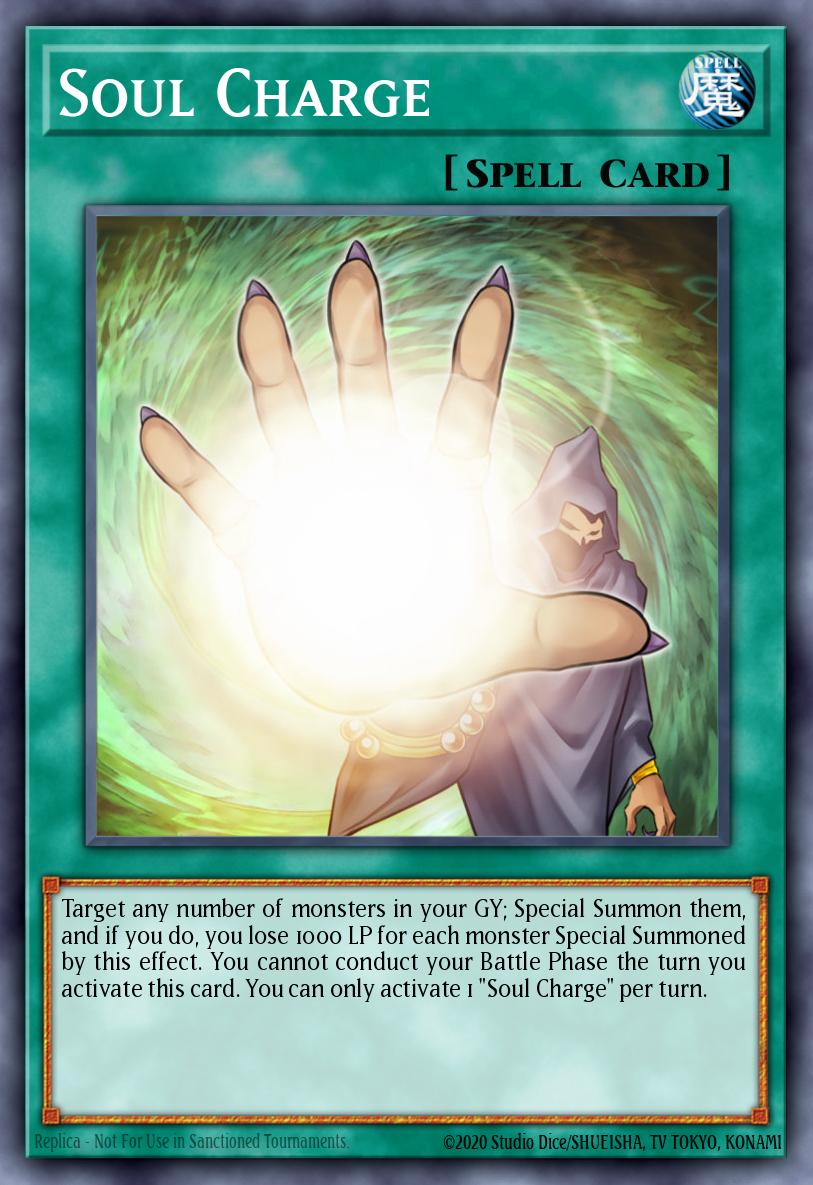 Soul Charge
Soul ChargeAs the dust settled after this new Forbidden List, the meta didn’t see a massive shift with the main change being the removal of Fire Fist from most top cuts. In their place, Geargia started to surge in dominance along with a new variant of Dragon Rulers that would go on to replace the Hieratic Ruler deck from the previous format: Mythic Rulers. This variant used two newer cards, Mythic Water Dragon and Mythic Tree Dragon along with Blue-Eyes White Dragon and the White Stone of Legend. Combined, these cards allowed for a deck that was able to easily access rank 8 Xyz monsters such as Divine Dragon Knight Felgrand and Hieratic Sun Dragon Overlord of Heliopolis. The main card that made this variant of Dragon Rulers work, however, was something released in the April booster set Dragons of Legend: Soul Charge. Soul Charge allowed for mass exploitation of powerful monsters in the Graveyard, meaning that being able to quickly fill the Graveyard could be directly translated into huge and powerful boards. Access to Soul Charge also allowed for Infernities to become even more relevant than they had been prior to the April 2014 Forbidden List due to the ease with which they could fill up their Graveyard.
Dragon Rulers wouldn’t be the only deck to exploit Soul Charge, however. Two other main decks of the format were able to effectively exploit the card: Infernities and Sylvans. Infernities, now with only a single copy of Infernity Barrier, had to move away from the more control oriented style they had previously played and focus more on a dedicated swarming strategy that relied on filling the field with Rank 4 Xyz by utilizing a combination of Infernity Archfiend and Soul Charge. The other deck that took advantage of Soul Charge were Sylvans, a deck that had been released earlier in 2014. The deck focused on excavating cards from the deck and filling the Graveyard with high level Plant-type monsters. Due to the ease with which the deck could easily fill the Graveyard up with level 7 and 8 monsters, Soul Charge became an extremely easy way for Sylvans to establish extremely powerful boards of high rank Xyz monsters. While this high power potential did allow Sylvans to see some success at high level events, the luck-based aspect of the deck’s strategy prevented it from ever truly entering the highest level of the meta.
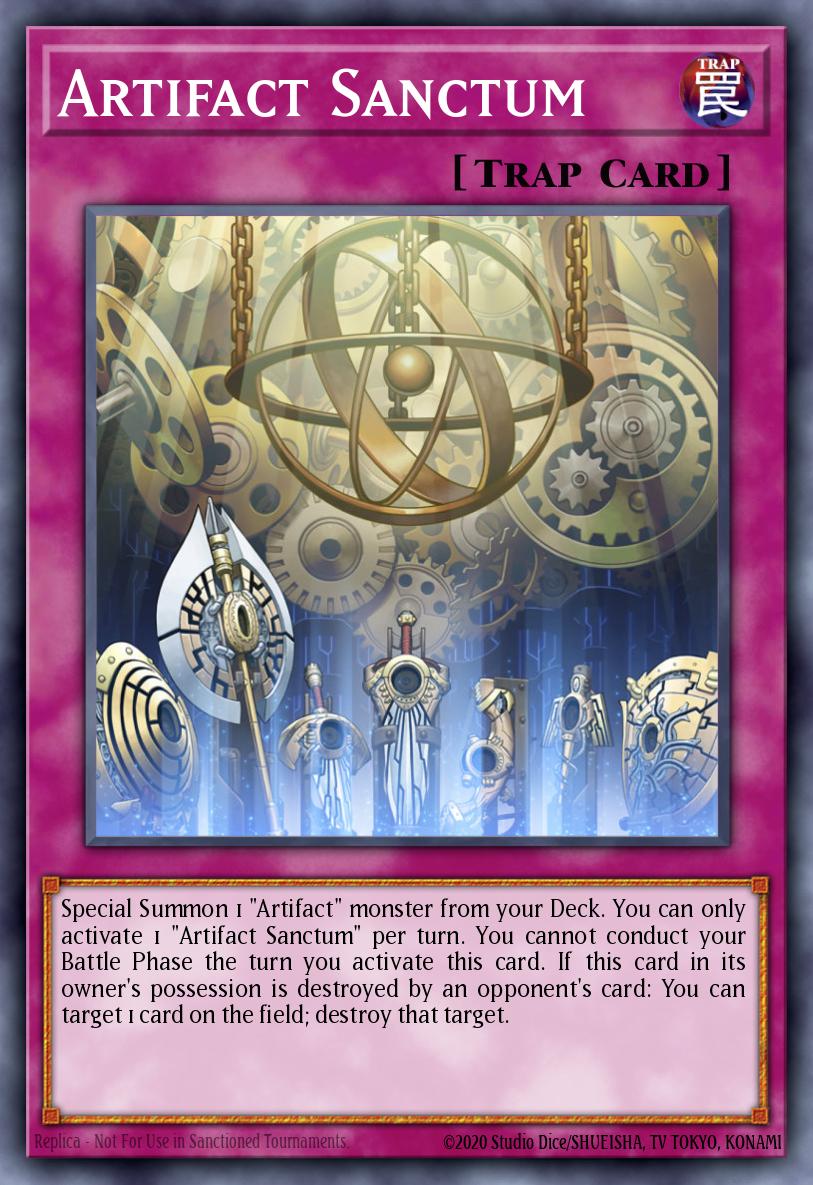 Artifact Sanctum
Artifact SanctumThe rest of this early April 2014 format would see a split of tops between Mythic Rulers, Geargia, and Mermails with more minor representation of Bujins and Hieratic Rulers. The meta would shift more dramatically with the release of a new set in May that brought a new archetype onto the scene: Artifacts. Artifacts are monsters that can be set in the Spell/Trap zone face-down and summon themselves when destroyed. Furthermore, Artifacts could disrupt an opponent through use of their Trap, Artifact Sanctum. Sanctum both Summoned an Artifact from the deck, triggering its effect, while also being able to destroy an opponent's card if it is destroyed. This gave players facing Artifact decks even more to fear before they attempt to destroy any face-down Spell or Traps their opponent controlled. While they never quite functioned as a dedicated deck, they instantly became a popular engine in all kinds of other decks. The deck they saw the most use in ended up being a hybrid deck that didn't revolve around any specific archetype: Hand Artifact Traptrix, more popularly known as HAT. The deck revolved around slowly generating card advantage through Fire Hand, Ice Hand, and Traptrix Myrmeleo while simultaneously being able to disrupt an opponent's plays with a well-timed Artifact Moralltach.
While the deck definitely showed its stuff as the most powerful deck in the meta going into the spring of 2014, the meta stayed very diverse. HAT was not an unchallenged deck as Geargia had shown that it could compete at the highest level and gained almost as many tops as HAT did. Now that the meta had managed to slow down somewhat, the consistency and board flooding capabilities of the deck were able to truly shine and give it a foothold as one of the more popular decks in the meta of the time. Madolche also managed to make a bit of a resurgence, seeing some success, especially at regional qualifiers. Madolche also managed to win the only YCS event held after Primal Origin was released, but due to this YCS occurring the same weekend that Primal Origin was released, HAT wasn’t as prevalent due to low supply of the new cards.
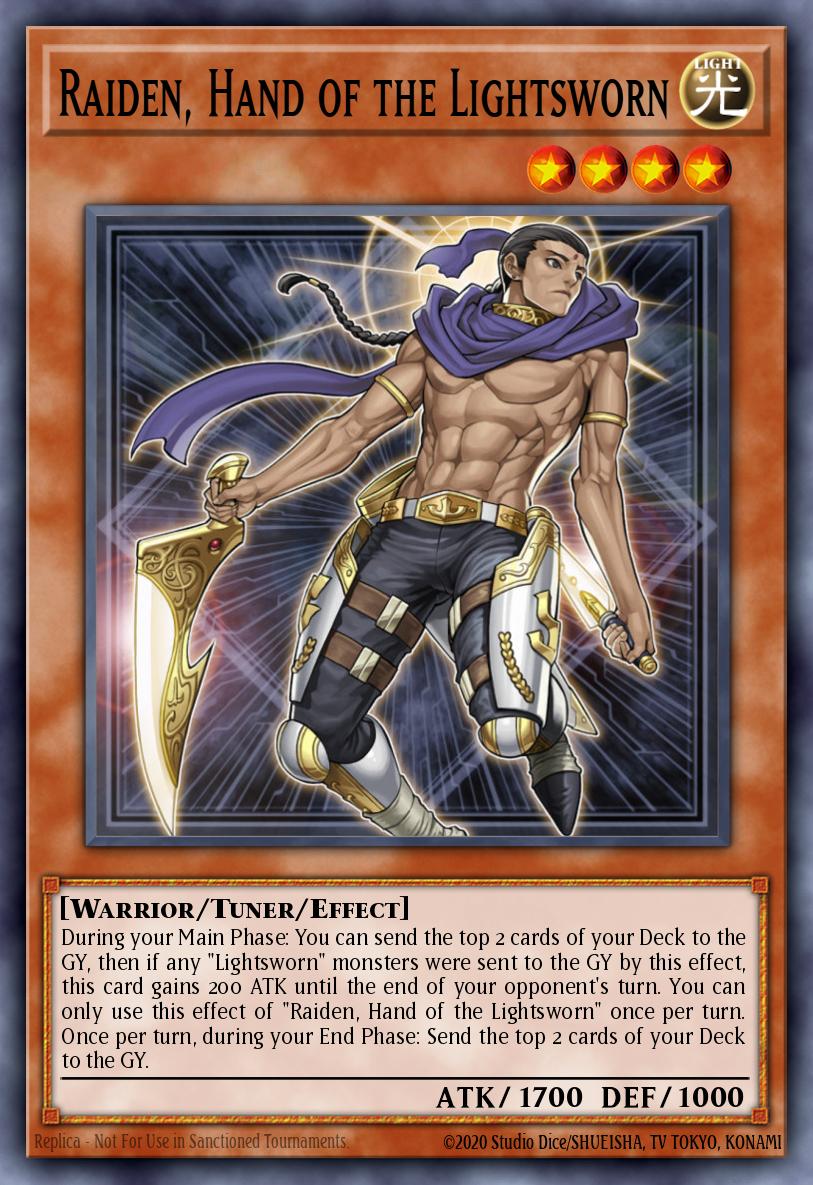 Raiden, Hand of the Lightsworn
Raiden, Hand of the LightswornFire Fists also managed to keep themselves in the meta by adapting to use Fire and Ice Hand to maintain advantage. This use of the Hand engine accompanied the rise in popularity of the so-called 3.5 Axis Fire Fist deck. This variant strayed away from the more dedicated rank 4 Xyz build and used rank 4 Xyz, rank 3 Xyz, and Synchro plays from Brotherhood of the Fire Fist Spirit. The format remained with HAT and Geargia on top until late June when a new Structure Deck was released that gave new and updated support for an older competitive archetype: Lightsworn. The most significant new support card was Raiden, Hand of the Lightsworn. Unlike previous Lightsworn cards, which had to wait until the End Phase to mill cards, Raiden was able to actively mill during the Main Phase in addition to the End Phase. This combined with his status as a level 4 tuner made him a very powerful new addition to the deck. This new support gave rise to yet another new competitive variant of Dragon Rulers called Lightsworn Rulers. The variant focused itself around using Dragon Rulers to easily banish Eclipse Wyvern to reliably get Judgment Dragon to hand.
Except for this addition of Lightsworn Rulers into the meta, the playing field remained relatively the same through to the July 2014 Forbidden List. While HAT won a large number of the National World Championship Qualifiers, other decks still saw significant success and tops throughout this format including Madolche and Geargia, but also Infernities, Bujins, and even Spellbooks. The July list was a very minor list with its only significant change being a hit to Geargia in the form of Geargiagear being Limited. Geargiagear had been the main card that enabled Geargia to flood the field as easily as they had been and without it, the deck was no longer able to keep up in the meta. This left HAT the dominant deck going into US Nationals, which it won.
The HAT meta wouldn’t manage to survive the summer, as a new set called Duelist Alliance would bring about a monumental shift in the meta. The release of this set marked the beginning of a new era of the game’s history. While many thought initially that this shift would be brought about by Pendulums, a new Summoning type much like Xyz and Synchro had been, the shift in the game’s meta was more nuanced. Unlike Synchro and Xyz, which had gone on to become the dominant strategies of their eras, Pendulum instead turned out to be simply another part of a much more diverse meta. The new era of Yu-Gi-Oh! that started with Duelist Alliance would see the rise of decks focused not only on the new Pendulum Summoning but also Xyz and Synchro as well as Fusion and Ritual summoning, two summoning methods that had previously not seen competitive play for years. The shift in the game would be spearheaded by these powerful new Archetypes, all of which were significantly faster and harder to get past than any Archetype before, the only excpetion being the Dragon Rulers themselves.
This shift from the HAT format to the Duelist Alliance format would mark, once and for all, the end of a slower game. The formats prior to Duelist Alliance had largely relied on smaller scale trades in card advantage that built towards one player slowly outpacing the other. This was marked by the prevalence of decks that focused on only summoning one or two monsters in a turn and the emphasis on traps such as Compulsory Evacuation Device and Bottomless Trap Hole that removed single monsters. The new meta would instead shift towards continuously filling the board with monsters and the popular traps stopped being one for one trades and started to trend more towards being extremely potent floodgates that shut an opponent out of entire game mechanics. Although this shift in power can be argued as having been either very good or very bad for the health of the game, it is undeniable that this shift away from the Xyz era would mark the start of the modern game of Yu-Gi-Oh!
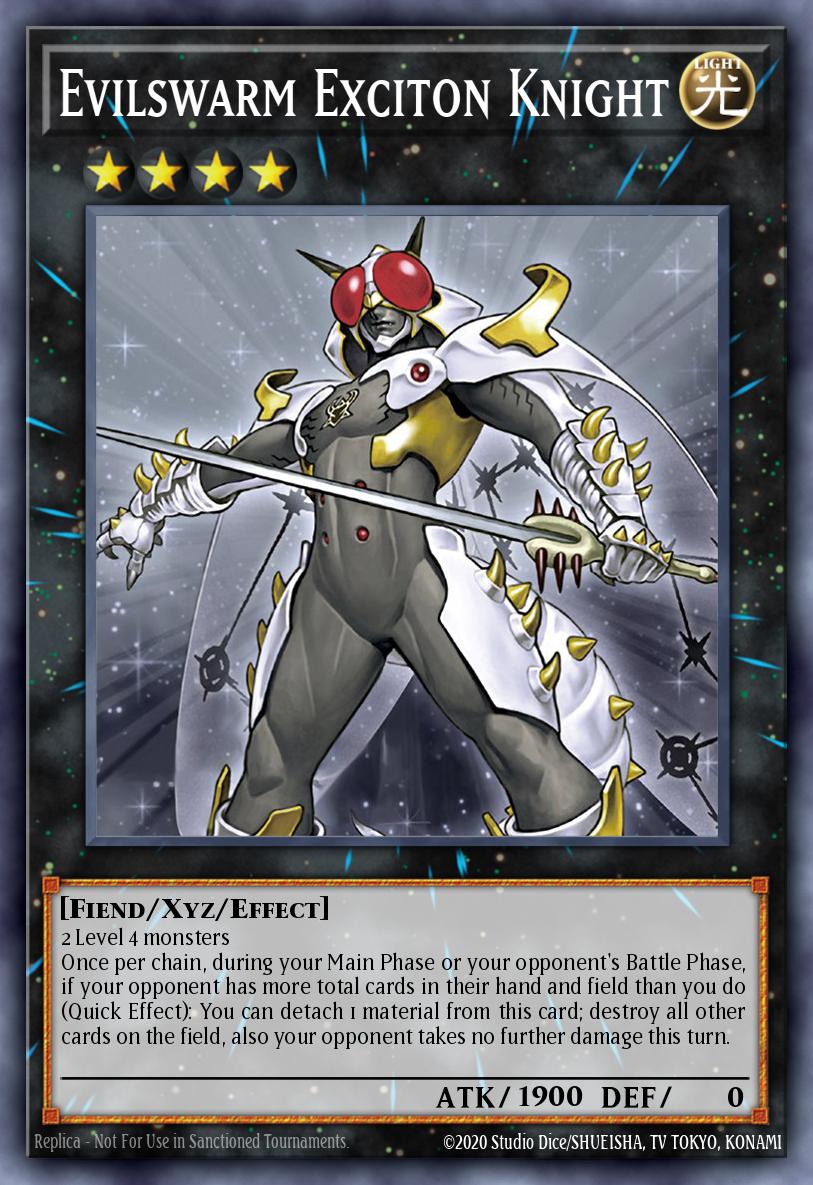 Evilswarm Exciton Knight
Evilswarm Exciton Knight




